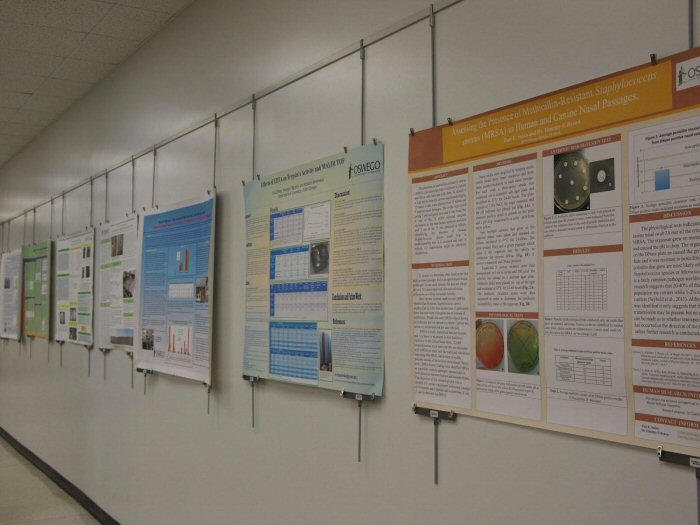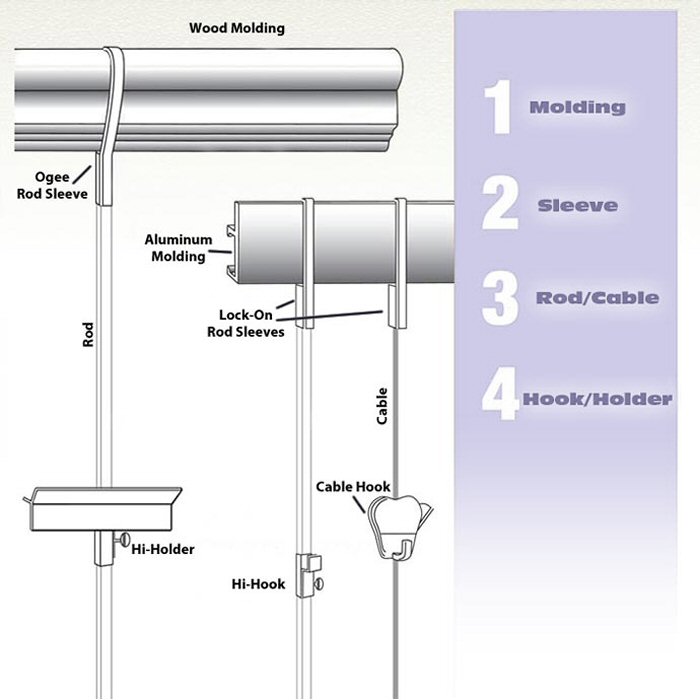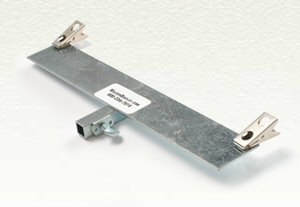Outreach to Science Faculty and Students Through Research Exhibitions
Tina Chan
Science Librarian / Exhibits Coordinator
tina.chan@oswego.edu
Chris Hebblethwaite
Coordinator of Reference
chris.hebblethwaite@oswego.edu
Penfield Library
State University of New York at Oswego
Oswego, New York
Abstract
Penfield Library at the State University of New York at Oswego (SUNY Oswego) has a gallery exhibit space near the front entrance that is used to showcase student-faculty research and art class projects. This article features the library's outreach efforts to science faculty and students through research exhibitions. The library held an exhibition for science research posters in Fall 2012 and Spring 2014. Requests were sent to science faculty inviting them to feature their student-faculty research posters in the library. The first request received 13 posters; the second request received 14. Research posters were displayed in the gallery exhibit space and inside the library cafe. We also discuss the hanging system used to display the posters. Having research posters displayed in the library in a visible, central, and active location, provided greater visibility to the broader campus community to view the latest research from science students and faculty.
Introduction
Helping to promote scholarship and creativity on a college campus can be a rewarding and satisfying experience. In fact, academic librarians can be valuable partners in this effort by offering space for activities and exhibitions that feature the scholarly and creative works of their students, faculty, and staff. Penfield Library at the State University of New York at Oswego (SUNY Oswego) has been providing such outreach for a number of years. Current programming includes International Games Day, an event held in the library cafe to play board games and an opportunity to play with Leap Motion technology. The library's ongoing Display to Archives features faculty and staff scholarship before it is preserved in the library archive. Other exhibits that regularly occur in the library include student projects from the art department, creative works from faculty and staff across campus in an event called "On My Own Time," and entries from the Dean's Writing Awards that are submissions of outstanding student writing (SUNY Oswego Writing Across the Curriculum 2014). For the past two years, the library has begun featuring student research from the science programs by inviting faculty to display the research posters of students they advise, sponsor, and/or collaborate with.
SUNY Oswego is a four-year comprehensive college that enrolls over 8,000 students, including both undergraduate and graduate students (SUNY Oswego Fast Facts 2014). The library has been developing a learning commons model of service, and the idea of displaying student scholarship and creative works is in keeping with this effort. The intention is to create an atmosphere that inspires learning and innovation by showing students what their peers have accomplished, and in turn, helping to build excitement about what they can achieve.
Posters about student and student-faculty research are generated for a variety of venues. Seniors at SUNY Oswego are required to do capstone research projects, and they have opportunities to do independent study that can lead to presenting at professional conferences. In either case, students are encouraged to present their research at an event each Spring called Quest. Quest is a one day symposium where students, faculty, and staff present their scholarly and creative contributions to the college community (SUNY Oswego Quest 2014).
Discovering the Concept
In Fall 2012, while walking through the science building and considering ideas for new work to show, the exhibits coordinator saw research posters from student-faculty collaborations on the corridor walls. Since mainly science students, faculty, and staff are the people who see this work, showing them in the library seemed like a good way to showcase these accomplishments to a broader population. As the library is a central location for research and study, it seemed a fitting venue for this type of activity.
A request for research posters was sent to science faculty inviting them to feature their student-faculty research posters in the library. In Fall 2012, six faculty submitted 13 posters, which were shown in the library's gallery exhibit space and inside the library cafe. Another invitation was sent in Spring 2014, when nine faculty submitted 14 student-faculty research posters.
Research Titles
In Fall 2012, the first time the research posters were shown in the library, most came from the biological sciences faculty. The original invitation was sent as a mass e-mail to all science faculty inviting them to participate, but this approach did not receive many replies. To generate more participation, personal invitations were sent and this received more responses. In Spring 2014, all science faculty were again invited to participate, and faculty who the science librarians knew had student or student-faculty research posters based on the Quest program were sent personal invitations.
Examples of research titles include:
- The Relationship Between Vegetation Composition and Oviposition Behavior of the Bog Buckmoth, A Rare Inhabitant of New York Peatlands
- Remediation of Toxic Metal Contaminated Soil: Long-term Effectiveness of Fishbone Apatite Amendment
- Extractions and Characterization of Lipids From Food Samples
- Metal Toxicity in Children: Apolipoprotein E and Lead
- Do Algal Communities Vary Between Vernal Pools at Rice Creek Field Station, Oswego, NY?
- Millimeter-scale Elemental Variability in Tufa From the Mono Basin, California
The diversity and caliber of research that students and faculty work on together deserves broad exposure. The library's exhibit space was the perfect venue for the campus community to learn about these collaborative efforts and to promote the library as a central location for research and study.
The Exhibit Space
Penfield Library has a gallery exhibit space near the front entrance that is used to showcase a variety of student, faculty, and staff accomplishments. Figure 1 shows one of the walls used for exhibitions. It is directly across from the circulation desk at the library's main entrance and is the most visible of the display areas. This image provides a good view of the hanging system that is used. It is called the Walker Display Picture Hanging System (Walker Display Incorporated 2014), which is composed of a molding that is installed permanently across the upper portion of the wall, and rods that can be hung from any location along the molding. A variety of hooks or clips can be attached to the rods depending on what needs to be displayed.

Figure 1
Figures 2 and 3 are images from the Walker Display Inc. web site, and show a close-up of the product and how it works. Figure 2 illustrates the aluminum molding that is mounted on the wall, and the rods (or cables) that hang from the molding. Figure 3 is an image of the clips used to hang the posters. The double clips on this device make it possible to hang the posters without needing to first mount them on a stiff backing. This saves time, effort, and cost.

Figure 2

Figure 3
Considerations
After inviting faculty to display their students' research posters during two separate semesters, a few helpful lessons were learned. As mentioned earlier, a mass e-mail sent to all science faculty was not fruitful. Instead, faculty responded best to personal invitations to participate in the exhibition, particularly if the invitation references known work presented at conferences or on campus.
It is important to give faculty time to print copies of the posters they want to submit. A two-week deadline seemed to motivate faculty to respond in a timely manner while giving them time for printing. It is also helpful to give faculty an idea of the approximate size of the poster(s) that can be accommodated. The hanging system is very flexible and can accommodate a variety of sizes. The expectation was that faculty would submit posters that were the size they would normally use when presenting at a conference or at Quest. If faculty need to print a copy of the poster, knowing up front how large they should be is helpful information for them to know.
Giving faculty a location to deliver the posters that is available throughout much of the business day contributed to timely deliveries. They were encouraged to drop their posters off at the reference desk, where the exhibits coordinator picked them up. The science librarians also offered to retrieve the posters from the faculty member.
Conclusion
The benefit of displaying research posters in the library is that anyone who enters can appreciate the research contributions of science students and faculty. The posters serve to highlight their diverse research interests and to enrich the learning experience for all. By displaying these posters in a visible, central, and active location, they receive greater visibility from the broader campus community. Through this outreach effort, science faculty can be reminded that librarians are there to help with their library needs, and that the library can be a place to highlight their scholarly efforts as well as those of their students.
References
SUNY Oswego Fast Facts. 2014. [Internet]. Oswego (NY): SUNY Oswego. Available from http://www.oswego.edu/about/facts.html
SUNY Oswego Quest. 2014. [Internet]. Oswego (NY): SUNY Oswego. Available from www.oswego.edu/quest
SUNY Oswego Writing Across the Curriculum. 2014. [Internet]. Oswego (NY): SUNY Oswego. Available from http://www.oswego.edu/academics/faculty/assembly/task_forces_and_committees/writing_across_the_curriculum/deansprizes.html
Walker Display Incorporated. [Internet]. Duluth (MN): Walker Display Incorporated. Available from: http://www.walkerdisplay.com/
| Previous | Contents | Next |

This work is licensed under a Creative Commons Attribution 4.0 International License.
